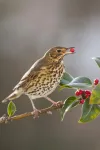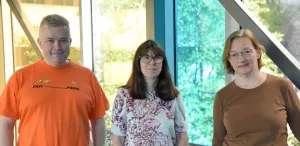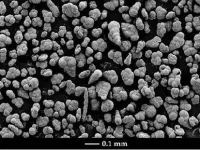(Press-News.org) ITHACA, N.Y. - Scientists at Cornell University and the American Museum of Natural History have identified 2,034 nearby star-systems - within the small cosmic distance of 326 light-years - that could find Earth merely by watching our pale blue dot cross our sun.
That's 1,715 star-systems that could have spotted Earth since human civilization blossomed about 5,000 years ago, and 319 more star-systems that will be added over the next 5,000 years.
Exoplanets around these nearby stars have a cosmic front-row seat to see if Earth holds life, the scientists said in research published June 23 in Nature.
"From the exoplanets' point-of-view, we are the aliens," said Lisa Kaltenegger, professor of astronomy and director of Cornell's Carl Sagan Institute, in the College of Arts and Sciences.
"We wanted to know which stars have the right vantage point to see Earth, as it blocks the Sun's light," she said. "And because stars move in our dynamic cosmos, this vantage point is gained and lost."
Kaltenegger and astrophysicist Jackie Faherty, a senior scientist at the American Museum of Natural History and co-author of "Past, Present and Future Stars That Can See Earth As A Transiting Exoplanet," used positions and motions from the European Space Agency's Gaia eDR3 catalog to determine which stars enter and exit the Earth Transit Zone - and for how long.
"Gaia has provided us with a precise map of the Milky Way galaxy," Faherty said, "allowing us to look backward and forward in time, and to see where stars had been located and where they are going."
Of the 2,034 star-systems passing through the Earth Transit Zone over the 10,000-year period examined, 117 objects lie within about 100 light-years of the sun and 75 of these objects have been in the Earth Transit Zone since commercial radio stations on Earth began broadcasting into space about a century ago.
"Our solar neighborhood is a dynamic place where stars enter and exit that perfect vantage point to see Earth transit the Sun at a rapid pace," Faherty said.
Included in the catalog of 2,034 star-systems are seven known to host exoplanets. Each one of these worlds has had or will have an opportunity to detect Earth, just as Earth's scientists have found thousands of worlds orbiting other stars through the transit technique.
By watching distant exoplanets transit - or cross - their own sun, Earth's astronomers can interpret the atmospheres backlit by that sun. If exoplanets hold intelligent life, they can observe Earth backlit by the sun and see our atmosphere's chemical signatures of life.
The Ross 128 system, with a red dwarf host star located in the Virgo constellation, is about 11 light-years away and is the second-closest system with an Earth-size exoplanet (about 1.8 times the size of our planet). Any inhabitants of this exoworld could have seen Earth transit our own sun for 2,158 years, starting about 3,057 years ago; they lost their vantage point about 900 years ago.
The Trappist-1 system, at 45 light-years from Earth, hosts seven transiting Earth-size planets - four of them in the temperate, habitable zone of that star. While we have discovered the exoplanets around Trappist-1, they won't be able to spot us until their motion takes them into the Earth Transit Zone in 1,642 years. Potential Trappist-1 system observers will remain in the cosmic Earth transit stadium seats for 2,371 years.
"Our analysis shows that even the closest stars generally spend more than 1,000 years at a vantage point where they can see Earth transit," Kaltenegger said. "If we assume the reverse to be true, that provides a healthy timeline for nominal civilizations to identify Earth as an interesting planet."
The James Webb Space telescope - expected to launch later this year -- is set to take a detailed look at several transiting worlds to characterize their atmospheres and ultimately search for signs of life.
The Breakthrough Starshot initiative is an ambitious project underway that is looking to launch a nano-sized spacecraft toward the closest exoplanet detected around Proxima Centauri - 4.2 light-years from us - and fully characterize that world.
"One might imagine that worlds beyond Earth that have already detected us, are making the same plans for our planet and solar system," said Faherty. "This catalog is an intriguing thought experiment for which one of our neighbors might be able to find us."
INFORMATION:
The Carl Sagan Institute, the Heising Simons Foundation and the Breakthrough Initiatives program supported this research.
What The Study Did: Hospital employees were surveyed about symptoms such as a rash, itching, hives or swelling around the face after receiving a messenger RNA COVID-19 vaccine.
Authors: Lacey B. Robinson, M.D., M.P.H., of Massachusetts General Hospital in Boston, is the corresponding author.
To access the embargoed study: Visit our For The Media website at this link https://media.jamanetwork.com/
(doi:10.1001/jamadermatol.2021.2114)
Editor's Note: The article includes conflicts of interest and funding/support disclosures. Please see the article for additional information, including other authors, ...
BOSTON - Skin problems such as itchiness, rashes, hives and swelling can occur in some individuals after receiving a COVID-19 vaccine, but it's not clear how common these reactions are or how frequently they recur with a subsequent vaccination. Research by led by allergists at Massachusetts General Hospital (MGH) now provides encouraging indications that the reactions are rare, and that even when they do occur with an initial COVID-19 vaccination, they seldom recur after receiving a second vaccine dose.
For the study, which is published in
JAMA Dermatology, a team led by Kimberly G. Blumenthal, MD, MSc, co-director of the Clinical Epidemiology Program within MGH's ...
What The Study Did: Researchers investigated the association between counties that adopted state mask mandates in Kansas with COVID-19 cases, hospitalizations and deaths.
Authors: Donna K. Ginther, Ph.D., of the University of Kansas in Lawrence, is the corresponding author.
To access the embargoed study: Visit our For The Media website at this link https://media.jamanetwork.com/
(doi:10.1001/jamanetworkopen.2021.14514)
Editor's Note: The article includes funding/support disclosures. Please see the article for additional information, including other authors, author contributions ...
What The Study Did: The hours worked and patterns of work activities among U.S. physicians before and during the COVID-19 pandemic were examined in this study.
Authors: Xiaochu Hu, Ph.D., of the Association of American Medical Colleges in Washington, D.C., is the corresponding author.
To access the embargoed study: Visit our For The Media website at this link https://media.jamanetwork.com/
(doi:10.1001/jamanetworkopen.2021.14386)
Editor's Note: Please see the article for additional information, including other authors, author contributions and affiliations, conflict ...
What The Study Did: Researchers examined family voucher-based kidney donations and the capability of voucher redemption to provide timely kidney transplants.
Authors: Jeffrey L. Veale, M.D., of the University of California, Los Angeles, is the corresponding author.
To access the embargoed study: Visit our For The Media website at this link https://media.jamanetwork.com/
(doi:10.1001/jamasurg.2021.2375)
Editor's Note: The article includes conflict of interest disclosures. Please see the article for additional information, including other authors, author contributions and affiliations, conflict of interest and ...
Migratory birds carry most seeds in the wrong direction to help plants cope with climate change, new research shows.
The study, published in Nature, reveals that the vast majority of plants from European woodlands are dispersed by birds migrating to warmer latitudes in the south, while far fewer are dispersed by birds migrating north.
As a consequence of global warming, the optimal climatic conditions of species are moving towards cooler latitudes, forcing the redistribution of life on Earth.
Mobility allows many animals to reach new areas with a suitable climate.
However, movement of plant species depends on the dispersal of their seeds at long ...
CHAPEL HILL, NC--Researchers at the University of North Carolina at Chapel Hill and the UNC Lineberger Comprehensive Cancer Center have uncovered a new mechanism that activates specific genes, leading to the development of cancers.
They showed that a mutation that fuses two unrelated genes can promote a process similar to that observed when oil and water are mixed but do not blend together. The process, called liquid-liquid phase separation, occurs inside a cell's nucleus and enables the formation of compartments with various physical properties that can promote cancers such as acute leukemias. Their findings will be published online June 23, 2021, in Nature.
"Phase separation and its role in cancer has been a missing puzzle piece in understanding this disease," said UNC Lineberger's ...
A joint research team led by Prof. LIU Zhongmin, Prof. WEI Yingxu, and Prof. XU Shutao from the Dalian Institute of Chemical Physics (DICP) of the Chinese Academy of Sciences (CAS) revealed the mechanism underlying the formation of the first carbon-carbon (C-C) bond formation during the methanol-to-olefins (MTO) process.
This study was published in Chem on June 23.
Prof. ZHENG Anmin's group from Innovation Academy for Precision Measurement Science and Technology of CAS was also involved in the study.
The first C-C bond in the MTO process is formed at the initial stage of the reaction. There is no direct method to elucidate the bond formation /reaction mechanism due to the difficulty in capturing intermediate species.
"We investigated the ...
A paper published in the prestigious journal Nature Medicine on long-COVID, describes persistent symptoms six months after acute COVID-19, even in young home isolated people.
The study from the Bergen COVID-19 Research Group followed infected patients during the first pandemic wave in Bergen Norway.
"The main novel finding is that more than fifty per cent of young adults up to 30 years old, isolated at home, still have persistent symptoms six months after mild to moderate disease", the leader of the group, Professor Nina Langeland explains.
The most common symptoms were loss of smell and/or taste, fatigue, ...
Pioneering research has shown marine ecosystems can start working again, providing important functions for humans, after being wiped out much sooner than their return to peak biodiversity.
The study, led by the University of Bristol and published today in Proceedings of the Royal Society B, paves the way for greater understanding of the impact of climate change on all life forms.
The international research team found plankton were able to recover and resume their core function of regulating carbon dioxide levels in the atmosphere more than twice as fast as they regained full levels of biodiversity.
Senior author Daniela Schmidt, Professor ...




